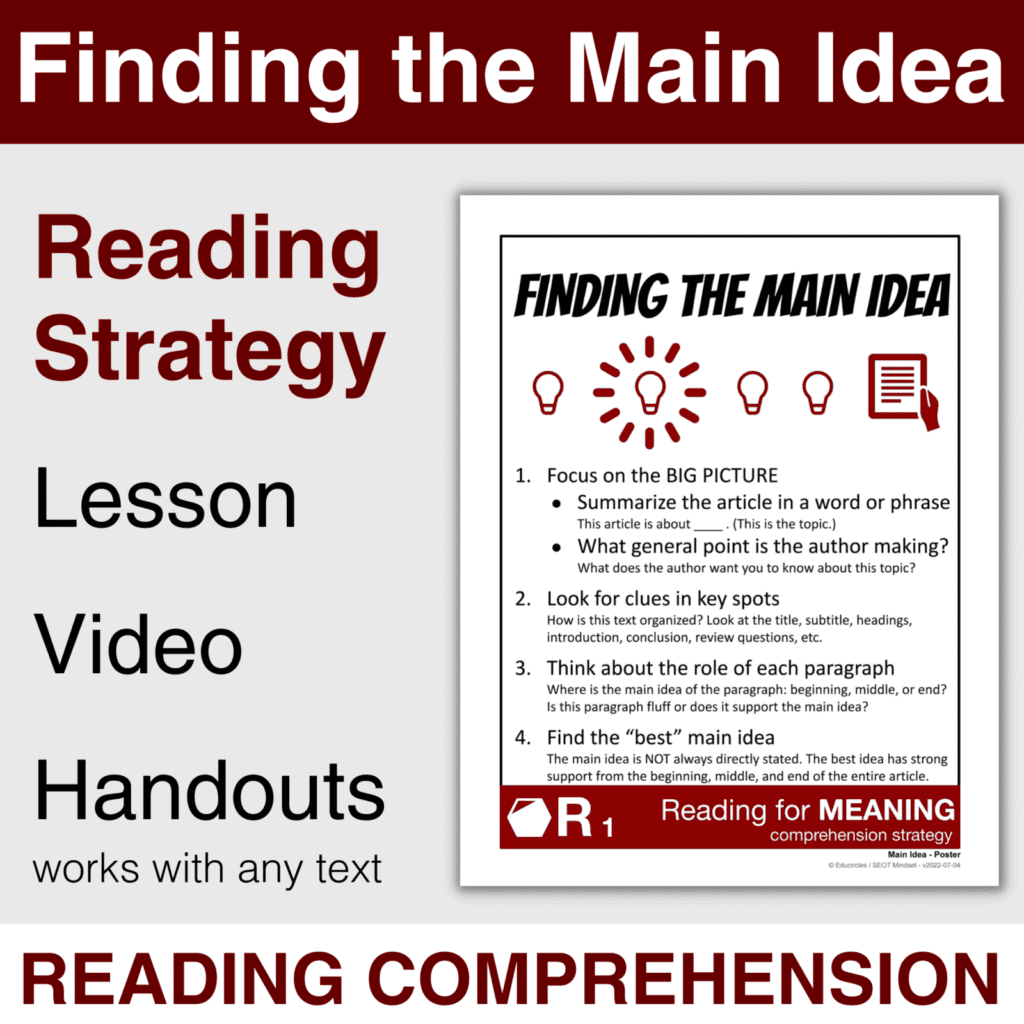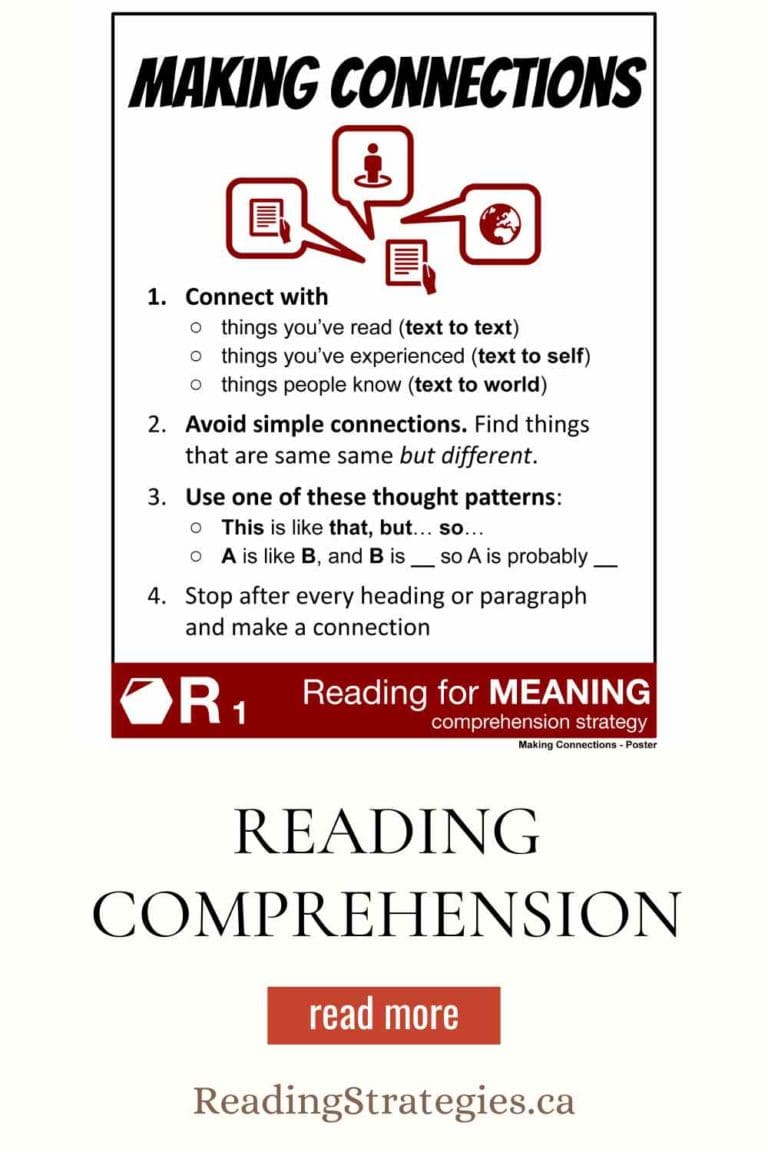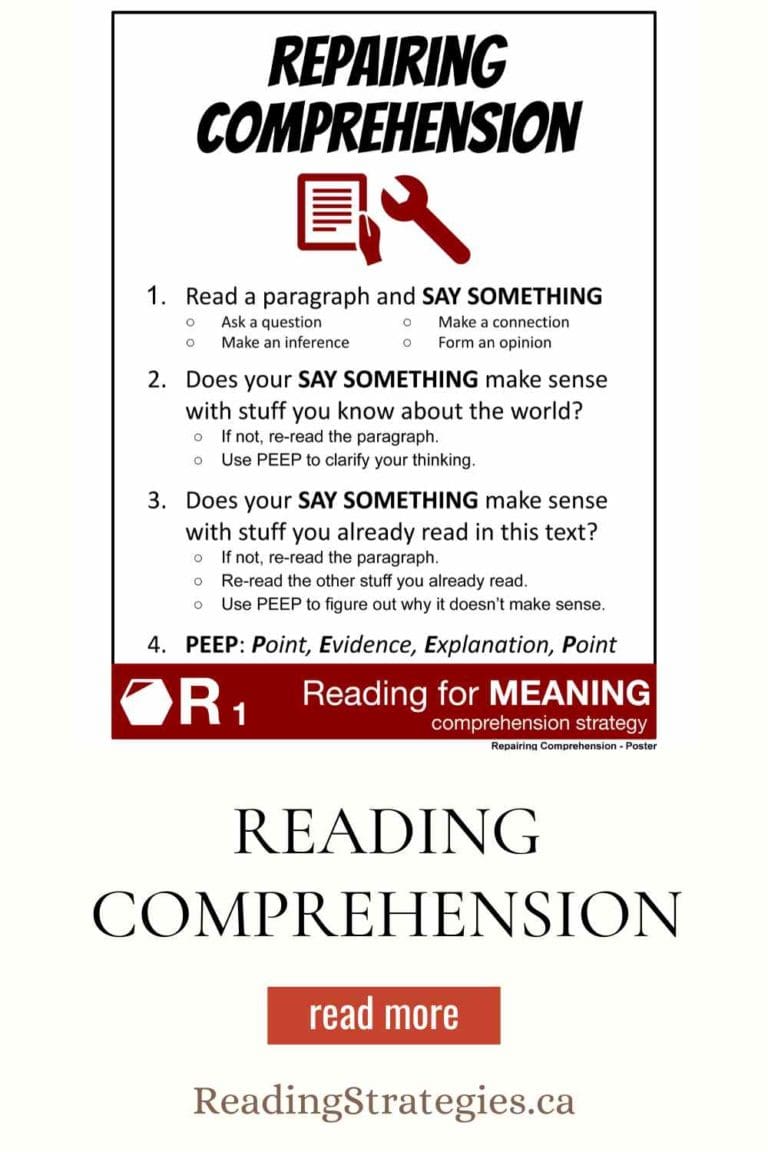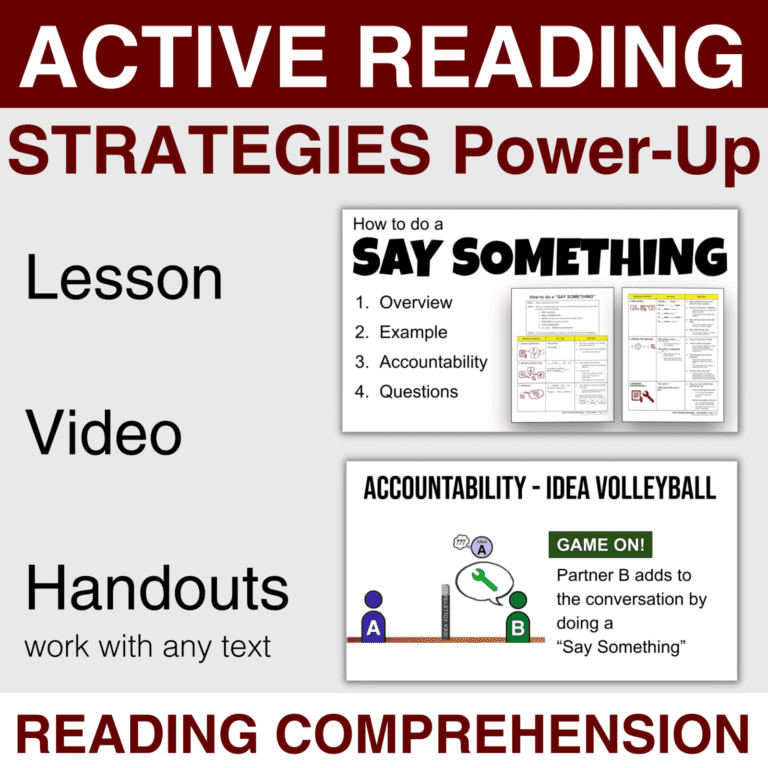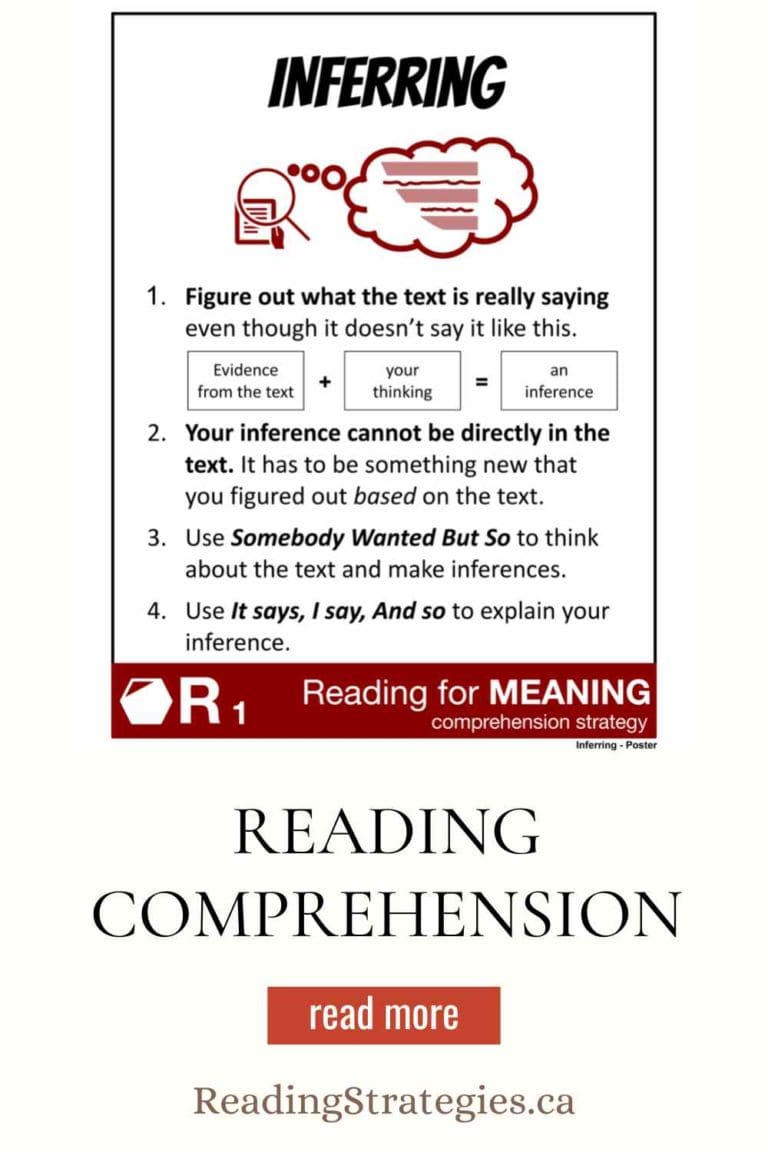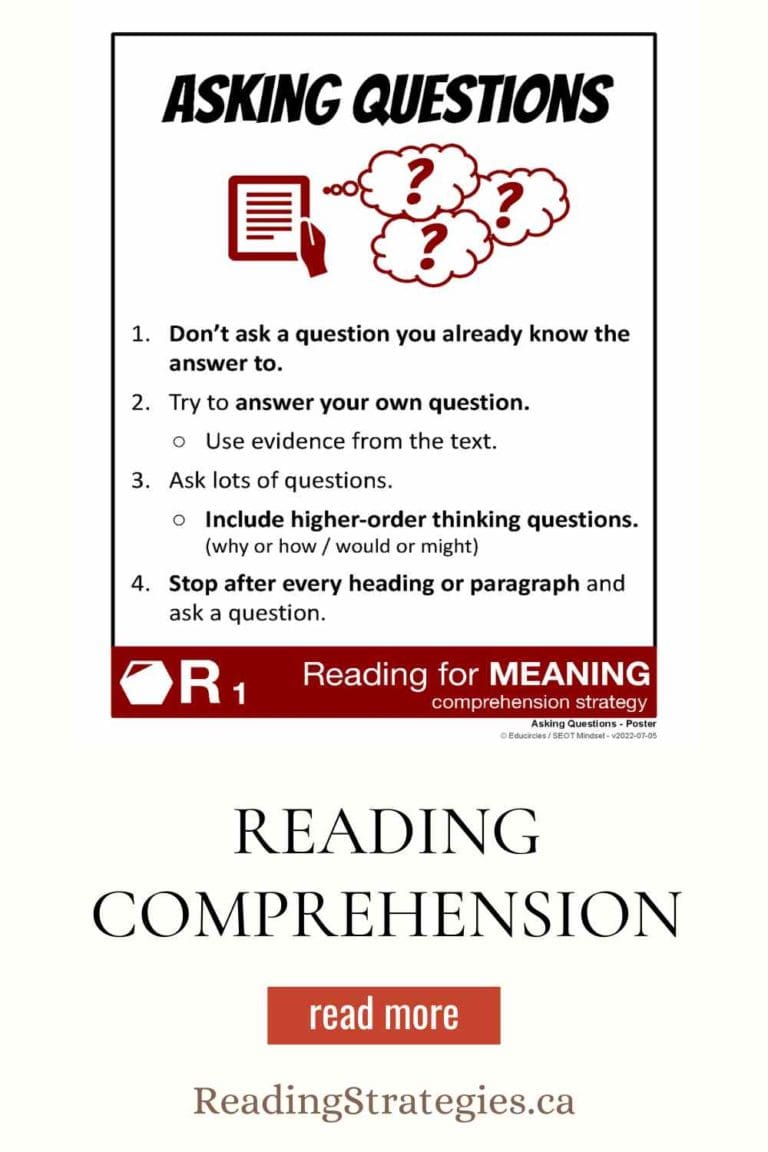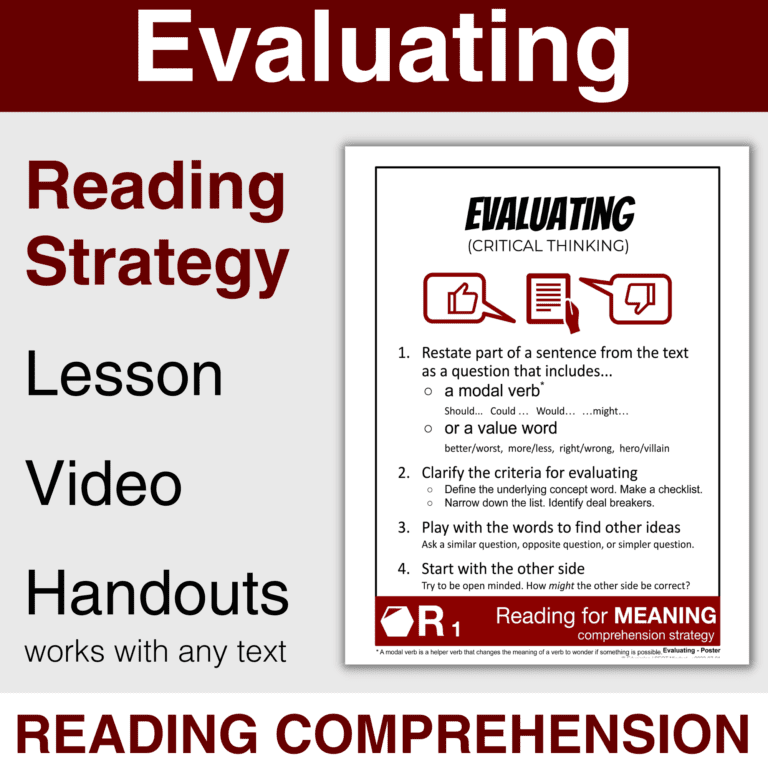Finding the Main Idea lesson plan UPDATE Nov 21, 2022
Finding the Main Idea is more than just figuring out what general point the author is trying to make.
It’s about recognizing that we can come up with several main ideas, but the “best” main idea has strong support from the entire article.
Use this lesson to give students a process to find clues in the organization of the text.
Active reading means looking at the information in each paragraph and deciding if it is “nice to know” side information or essential information that develops the author’s point.
How to EVALUATE and FIND THE BEST MAIN IDEA (4 PRO TIPS):
- Focus on the BIG PICTURE (the entire article). Summarize the entire article in a word or phrase. What general point is the author trying to make?
- Look for clues in key spots. (How is the text organized?)
- Think about each paragraph. What is this paragraph about? (Where is the main idea in the paragraph? Beginning? Middle? End?) What role does this paragraph play?
- Find the “best” main idea. The main idea is NOT always directly stated. The best idea has strong support from the beginning, middle, and end of the entire article.
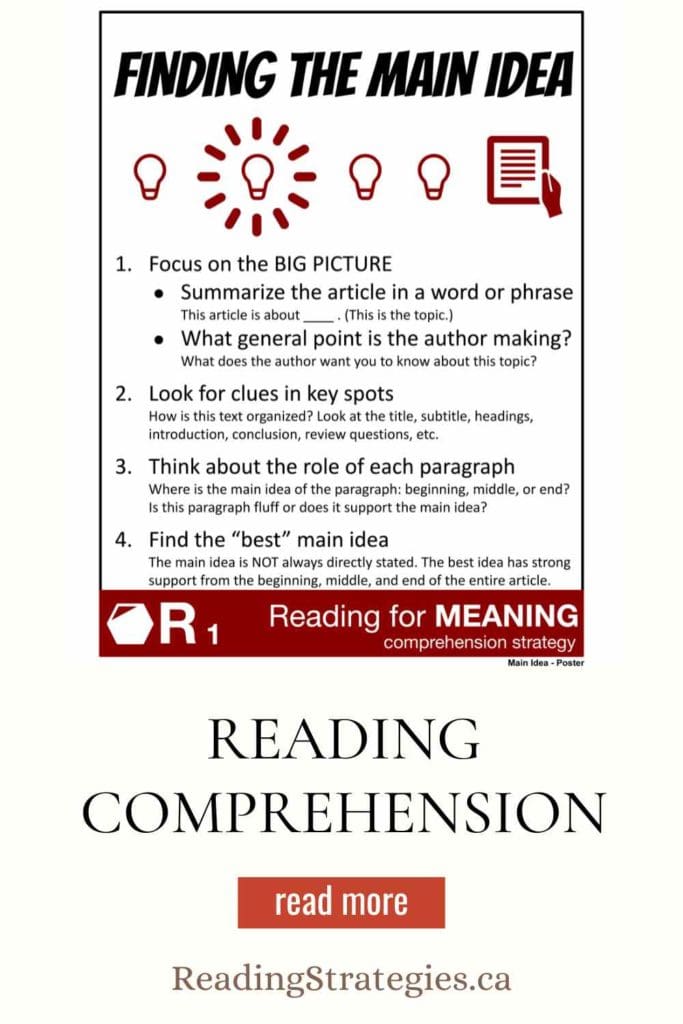
If you want this product with reading texts, please check out our Reading for Meaning Comprehension Strategies bundle.
Watch the FREE Reading Comprehension Video.
Hi everyone it’s Mike from Educircles and today is part of our Reading for Meaning series, we’re going to be talking about the comprehension strategy called Finding the Main Idea.
Now before we talk about this reading strategy, let’s review active reading.
- Active reading means we think about the text as we read.
- We don’t just say the words – we think about the words and what the words actually mean.
If we use strategies, we can get better at reading. Comprehension strategies help us figure out what is happening in a text.
Today, we will use a strategy called Finding The Main Idea.
Finding The Main Idea is about looking at the big picture of an article. We’re asking what general point is the author trying to make.
It’s not always easy to find the best or biggest main idea.
- The author will write several sentences and paragraphs – and in the article, there will be several key points and ideas.
- The best main idea is the overall central idea of the entire article.
- So, in this example, the big idea might be that this is a soup ladle.
Finding the main idea is like looking for constellations in the night sky.
A constellation is a group of stars in a recognizable pattern.
For example, this is the Big Dipper. If you know where to look it’s easier to see the patterns.
(Did you know that if you extend the line between the last 2 stars in the Big Dipper, you can find the North Star?)
When we read, we need to look for clues in key spots of the text.
- We need to ask ourselves, how is the text organized?
- We think about the big picture and we try to look at the entire article.
Here are 4 pro tips to help you find the main idea.
Find the Main Idea – Pro Tip #1: Focus on the Big Picture
Pro Tip #1 is to focus on the big picture – that means thinking about the entire article.
Summarize the entire article in a single word or phrase. What general point is the author trying to make about that topic?
We’re going to be looking at a series of examples.
Finding the Main Idea – Example #1: Photograph
Let’s look at example #1 which is a photograph.
- Here’s the photo.
- Summarize this entire media text in a single word or phrase.
- In other words, what is this image about?
What is the topic?
You might say stars, night, the universe, being alone, life on other planets…
Then, we have to ask ourselves what is the author saying about the topic. Maybe that “astronomy is the science of stars in space” or maybe the author is trying to say that “night is beautiful”, “the universe is expanding”, “being alone can be a good thing”, “Is there life on other planets?”
Any of these could be the main idea, but which one is the best main idea?
We need to try to figure out what is the photographer trying to say with this photo? Maybe the message is that “night is beautiful” or “being alone can be a good thing”. Or, maybe the photographer is trying to capture a sense of wonder about life on other planets. We need more information to figure out which of these might be the best main idea. Maybe there are other clues somewhere else.
Pro Tip #1 Recap
Let’s review Pro Tip #1.
Focus on the big picture – which means the entire article. Try to summarize the entire article in a single word or phrase. Ask yourself, what general point is the author trying to make.
Find the Main Idea – Pro Tip #2: Look for clues in key spots.
How is the text organized? Is there a title or subtitle? Are there headings or subheadings? Is there an introduction? Body paragraphs? A conclusion? Are there review questions?
Let’s look at example #2 which is an informational text that has 5 paragraphs.
Let’s zoom in.
Lorem ipsum is placeholder text that we use in web design. It gives us a sense of layout without having to use actual sentences. Many people just look for meaning in the sentences, but we can find a lot of clues hiding in the text organization.
That’s why in this lesson, there are fake words in the sentences. It’s to help us focus on the text form and structure instead of the words themselves.
Pro Tip #2 is about look for clues in key spots and the guiding question right now is how is the text organized?
Here’s the typical format for most informational texts.
- You have a title which gives us a big hint about the topic and the general point.
- The beginning of the article usually introduces what we’re going to find out in this article.
- The middle of the article usually includes supporting details that the author uses to explain their point
- Finally, at the end of the article, we often see a conclusion that summarizes what the author just told us.
Finding the Main Idea – Example #2: Five Paragraph Essay
This is a 5 paragraph essay.
- We have a catchy introduction to hook the reader.
- The last sentence in the introduction is usually the thesis or main idea and a quick introduction to the 3 ways the author is going to prove their point.
- Then in the body paragraphs, we have 3 ideas that prove the author’s point. We have reason #1, reason #2, and reason #3.
- Finally, in our conclusion paragraph, we usually restating the thesis – we restate our general point that we’re trying to make, and we briefly summarize our 3 reasons that we just told you about in the body paragraphs.
- We often finish our conclusion paragraph with a thought-provoking ending.
If we were doing a reading test on a 5 paragraph essay, we would know where to look in each paragraph and this could help us figure out the main idea of the essay.
The problem is most texts aren’t 5 paragraphs long.
Good writing is not always obvious and formulaic, but there are still patterns in how informational texts are organized. And we can use these patterns to help us figure out the main idea.
So, let’s look at example #3 which is an informational text that now has 20 paragraphs.
We’re going to start with our 5 paragraph essay and then add a bunch of line breaks. This means that if we were working on this article on our computer, we would literally hit the enter key to break apart longer paragraphs into shorter paragraphs.
We’re going to play with the structure of our paragraphs. Website articles typically use shorter paragraphs because shorter paragraphs are easier to read online.
- So, here we have our beginning. We have the same words in the beginning, but we broke the paragraph up differently.
- Here we have reason #1 – which has the same words in the sentences, but again we hit enter in the paragraph to break the paragraph up differently.
- We did the same thing in reason #2 and again in reason #3, splitting up the paragraph into shorter paragraphs.
- Finally, in the conclusion, we have the exact same words in the sentences, but we broke the paragraph up differently.
Finding the Main Idea – Example #4:
Now, this essay has 20 paragraphs.
A 20-paragraph essay has the same structure – the same pattern – as a 5-paragraph essay. Let’s look at the two.
- We have a title where we have the topic or the point of the article.
- We have a catchy introduction to catch the reader’s attention.
- We introduce the main idea of the article.
- Then, we explain reason #1 – this is our 1st idea supporting what we’re trying to say with this article.
- Then, we have another reason to prove our main idea.
- Finally, we have a third reason supporting our main idea.
- Then, at the end, we summarize what we just told the reader – we summarize the main idea and we include a thought-provoking ending.
Let’s look at example #4 which is an informational text that has 20 paragraphs, but now we’re going to add headings and subheadings.
One way to make your article easier to read and quickly understand is to use headings and subheadings to organize information.
- So, for example, in the title area we might have a title, but we might also add a subtitle to give more insight into what we are trying to say with her article.
- Then, in our reason #1 section, we might add a heading and a subheading. We can also split paragraph into bullets to make those sentences easier to read.
- In reason #2, we could add a heading here as well will split paragraph into bullets again to make things easier to read.
- In the 3rd reason section, we could add a heading and then add multiple subheadings to clarify our arguments and ideas.
- Finally, in the last part of the article, we could add a heading to make it obvious to the reader that this is our conclusion and we are wrapping things up.
This text now looks longer, but it still has the exact same organization: we have a beginning, a middle, and an end.
Finding the Main Idea – Example #5
Let’s look at example #5 which is an informational text that has 20 paragraphs, headings and subheadings, and now we’re going to add images.
We use images to support what we are saying in the text.
- So, in the introduction, we might start with a catchy image to hook the reader’s attention.
- In reason #1, maybe we’ll add an image and a caption to provide more context to the ideas.
- We can add another image for the next idea in reason #2. Maybe, we’ll add an image to explain what we’re talking about there.
- Then, in reason #3, we can add some images to enhance the text and make it more interesting to read.
- In the end, we don’t have to make a change. We could add an image, but we don’t have to.
This text again looks longer but, remember, it still organized like a 5 paragraph essay with a beginning middle and end.
Imagine we read this article on a mobile device. It’s still the same structure as a 5 paragraph essay that we talked about earlier even though it looks very different.
- We have a title.
- We have a catchy introduction where we introduce the main idea.
- We have idea #1 with supporting details.
- Then, if you scroll down, we can see idea number 2 that also has more supporting details.
- If you keep scrolling down in the article, we have idea #3 which again supports the article’s main idea.
- As we scroll through the article here, we can see the conclusion of the article that summarizes the point the author was trying to make and often includes a catchy ending.
Now let’s look at one more example.
Finding the Main Idea – Example #6: Textbook
Example #6 is an informational text with 20 paragraphs, headings and subheadings, images, and instead of having the layout for a mobile device, we’re going to change the layout to fit a standard piece of paper.
If we shift where the images are located to fit on paper, what started as a 5 paragraph essay now looks like a textbook.
- Here are the first two pages.
- The next two pages…
- Here are more pages,
- and then finally we have the end of this section.
- Textbooks often ask questions to see how well you understand the point the author is trying to teach you.
A textbook looks longer and more complex but, again, it is still organized like a 5 paragraph essay with a beginning, middle, and end.
- We have the title
- We have a catchy introduction that may span several pages.
- We introduce the main idea of this chapter
- Then we explain the first concept to supporting the point of this chapter.
- Then we go on to explain a second concept to backup the main idea of this chapter.
- Finally, we have a third concept section to develop the main idea
- At the end of the chapter, we have a chapter conclusion which summarizes what the chapter was about. There is usually a thought-provoking end about the significance of this chapter.
- In a textbook, we would have chapter questions for students to test their thinking.
So, as you can see, there are patterns in how informational texts are written. It doesn’t matter if you’re reading a 5 paragraph essay, a 20 paragraph essay, a website article, or a textbook – we can look for clues in key spots.
Remember, in a classic, formulaic 5 paragraph essay, you have 3 body paragraphs, each with 3 supporting details. But, of course an author could only have 2 reasons to prove their point. Or, maybe they have 20 reasons why they think something should happen. Either way, the structure is the same. There’s, a beginning, middle, and end.
Pro Tip #2 Summary
We look for clues to help us figure out the authors point in key spots by asking how the text is organized. We look in key locations like titles and subtitles, headings and subheadings, the introduction, body paragraphs, the conclusion, and review questions if there are any.
Find the Main Idea – Pro Tip #3: What role does each paragraph play?
Look at Pro Tip number 3 which is to think about each paragraph as you read it.
- Think about what the individual paragraph is about.
- Where is the main idea of this paragraph? Is it at the beginning of the paragraph, the middle of the paragraph or at the end of the paragraph?
- Ask yourself what role this paragraph plays in the article. Is the information in here catchy fluff or is this essential information to the article that helps prove the author’s point?
Here is the classic model for paragraph writing. It’s called the hamburger model.
- We start with a topic sentence which is like the bread at the top of your hamburger. The topic sentence explains what your paragraph is about.
- Then, you have multiple layers of ingredients. You have a supporting sentence which might be some tomato. Then, you have a 2nd supporting sentence which might be a slice of cheese. You might have a third supporting sentence which could be some lettuce. Maybe you even have a fourth supporting sentence which could be the beef patty.
- Finally you end your hamburger with another piece of bread which is your conclusion sentence.
Finding the Main Idea – Example #7: Paragraph – hamburger model
Let’s look at example #7 which is a paragraph and the main idea of this paragraph is in the beginning.
- So here’s some Lorem Ipsum text.
- The topic sentence – what our paragraph is about is at the beginning.
- Then, we have body sentences that support the topic sentence and develop the idea.
- Finally, at the end, we have a conclusion sentence that summarizes the paragraph.
Where is the main idea in this paragraph?
- it’s stated at the beginning, then it gets backed up by supporting ideas.
But, we can organize a paragraph in different ways.
Finding the Main Idea – Example #8: Paragraph – pizza model
Here’s example #8 which is a paragraph but the main idea of the paragraph is at the end. We might call this a pizza model where you have…
- a catchy introduction to hook the reader at the top – maybe that’s like bacon on top of your pizza.
- Then, you can have supporting ideas. Supporting sentence #1 could be the pepperoni. Supporting sentence #2 could be the cheese
- Finally, at the end, you might have a conclusion sentence where you make your point. That’s the crust in our pizza.
if we look at some Lorem Ipsum text in a paragraph, we can see…
- here is a catchy introduction that has several sentences to try to hook the reader
- Then, we go into supporting sentences that build up to…
- the conclusion sentence where we make our main point.
Where is the main idea this paragraph? It’s at the end.
In this style of paragraph, we start with a catchy intro, then we start to introduce ideas that build up our case and lead the reader to our main idea at the end.
Sometimes, the main idea is not at the beginning or end.
Finding the Main Idea – Example #9: Paragraph – hamburger with bacon
Here’s example #9 which is a paragraph that has the main idea in the middle of the paragraph. We might call this a hamburger model with bacon on top.
In this example…
- the bacon might be a delicious catchy introduction that hooks the reader’s attention.
- Then, we still have our top bread layer which is our topic sentence where we explain what the paragraph is about.
- Next, we have some supporting sentences to backup the ideas in our topic sentence.
- We might have a concluding sentence, we might not.
Now, if you look at an example of Lorem Ipsum text, we can see…
- here’s the catchy introduction to hook the reader.
- Then, we have our topic sentence,
- Followed by a supporting sentence and or two to prove our topic sentence.
- We don’t always have a conclusion sentence, but in the classic hamburger model, we do.
Where is the main idea in this paragraph? It’s in the middle.
In this style of paragraph, we start with a catchy introduction that leads to the author’s point and then develops that idea with supporting ideas at the end.
As we read each paragraph in an article, we’re thinking about what the paragraph is trying to say by looking for the main idea in the beginning, middle or end of the paragraph.
- We have the hamburger model where the main idea is in the beginning,
- the hamburger with bacon on top model where the main idea is in the middle,
- and then we have a pizza model where the main idea is at the end.
As you read each paragraph, ask yourself
- What role does this paragraph play in the big picture of the article?
- Is this paragraph contain catchy fluff to hook the reader, or
- is it essential information that helps to develop the main idea of the article?
- Is this important and relevant to the point the author is trying to make or is this stuff just nice to know?
If we think back to example #3 which was an informational text that had 20 paragraphs, remember it started with a title and then went on to a catchy introduction. Then, we saw the main idea, idea #1, and so on.
Here’s what our mind might have thought if we could understand Lorem Ipsum text.
As we read each paragraph, we would be asking ourselves, what is this paragraph about and what role does this paragraph play in the big picture?
We might read the 1st paragraph and we might say the main idea is at the end of this paragraph. Then, we ask, okay, well, what purpose does this paragraph play? We might say this is probably “nice to know” information – it’s just a catchy hook to grab our attention
Then we read the 2nd paragraph – you might say, well what is this paragraph about? And then after thinking about it, we might guess the main ideas is in the middle of this paragraph. We ask ourselves what role does this paragraph play and we might say, well this is more “nice to know” information because it’s still trying to be catchy. It’s still part of the bacon trying to catch the reader’s attention to get them to read more.
When we read the 3rd paragraph, we’re constantly thinking at the back of our mind, “what is this paragraph about” and we might think that the main idea is at the beginning of the paragraph here. We might say, well, this seems like it’s more nice to know information, but it feels like it’s building up to something – so I think this is probably still part of the article introduction. I don’t think the author has said what their main idea is yet.
So, we keep on reading the next paragraph and we might say, okay, well, look the main idea of this paragraph is definitely at the beginning and I think this paragraph is really important because I think this is the point that the author was leading up to in their introduction. They also have introduced a list of a few things – so I’m guessing they’ll probably discuss these later in this article.
So, we keep on reading – there are no headings in this article to give us hints, so we have to base our ideas purely on what the paragraphs say.
We might read this paragraph and say, well, the main idea of this paragraph is at the beginning – and in fact, this is probably important – I think it’s the first big reason that the author is using to prove their point because I can see it connects with the stuff in the last paragraphs. So, that last paragraph was probably their thesis – their main idea.
As I keep on reading, I might say, okay, well in this paragraph, I think the point of the paragraph is here in the middle because this paragraph seems to be supporting this section about the main idea. The first part is just a catchy description, but the rest of the paragraph seems like it’s actually really important because it’s all about the author’s first big reason.
Pro Tip #3 Summary
Let’s recap Pro Tip #3 which is to think about each paragraph.
- We ask ourselves what is this paragraph about. We thought about where the main idea of the paragraph was and we know that main idea could be at the beginning, middle, or end of a paragraph.
- We also think about what role this paragraph plays in the big picture – is this catchy introduction stuff or thought-provoking conclusion stuff or is the meat of the article – essential information that develops the author’s point.
Find the Main Idea – Pro Tip #4: Not all main ideas are good main ideas
Here’s Pro Tip #4 which is to find the best main idea.
- The best main idea has strong support from the entire article – the beginning, middle and end.
- The main idea is not always directly stated by the author. We may have to infer what the author is really saying about the topic.
- Sometimes, the whole is greater than the sum of the parts. That means, although you can find important hints in key locations about what the author is trying to say about the topic, if you’re only looking at a narrow slice of the article, you might be missing important information.
- The best main idea has strong support from the entire article – not just one part.
- Although an author may directly state why they are writing about the topic, the way they write might tell another story.
- In other words, there may be another unsaid-but-better-main-idea that captures the point of the article that we can infer based on the examples that the author used and their word choice.
Pro Tip #4 Summary
Let’s recap Pro Tip #4.
- It’s about finding the best main idea which has strong support from the entire article.
- The main idea is not always directly stated by the author
- We may have to infer what the author is really saying about the topic.
Okay, practice time.
Here is a sample article. What do we do first – and we can do this before we even start reading.
What was Pro Tip #1?
Pro Tip #1 is to remember to focus on the big picture as we read
- So even before we read, we’re thinking about this and as we read, we’re trying to summarize the entire article in a single word or phrase (that’s the topic)
- and we’re trying to piece together what point the author is trying to make about the topic.
What do we do as we read?
What was Pro Tip #2?
Pro Tip #2 is to look for clues in key spots of the article. We do this by asking ourselves how the text is organized.
Even without reading the article, we know that there will be a beginning, middle and end.
We know at the very beginning will be a title that gives us a clue. For example, in this case it says “Green leader” and we have to ask ourselves what could the topic or the author’s point be based on this clue?
- Maybe it’s someone who is a leader in environmental issues. (Being green is usually about the environment.) Maybe this is an action movie thing like leader of the Green Squadron.
The subheading tells us “Green leader says it shouldn’t have taken this long” so then it makes me wonder what shouldn’t have taken this long?
- maybe environmental change is taking too long but it finally happened?
- maybe standing up for climate change?
- I’m not sure what should not have taken this long.
We’re still on Pro Tip #2 – we’re still looking for clues in key spots even before we read this article.
At school, sometimes we have to read an article or a textbook and then answer questions. If we look at the questions before we read the article, it can give us a big clue about what to pay attention to as we read.
In this case, the questions can give us a clue about what the topic or the author’s point might be.
The first line here in the question section says, “based on the article and the collaboration mini lesson, how would you answer the following?”
- right away, I see it says “collaboration mini lesson” so I have to make sure that I read that before answering these questions.
- I notice there’s a third page in this handout package and the title of that section says “collaboration mini lesson” – good to know.
If I go back to the chapter questions at the bottom of the article I see the first question is “why does Annamie Paul becoming leader of the Green party of Canada make a difference for some people?”
- So, now I think Green Leader – well okay, so this is about the leader of the Green party of Canada – maybe the Green party is called the Green Party because they care about environmental issues? Maybe the author of this article has something to say about Annamie Paul becoming the leader.
The 2nd question is “Do people from different cultures, genders or lived experiences have very different points of view?”
- so I might think when I see words like culture or gender, I wonder if this article is about stereotypes or racism or sexism or thinking about whether people are different or have different experiences…
- Maybe if I tie it back to that first question – maybe her becoming the leader of the Green party of Canada – maybe that has to do with her culture or her gender or something that she has personally lived through?
The third question ask if different points of view help collaboration or get in the way?
- So then it makes me wonder if this article is about people working together or being divided? and that ties into the previous question about whether or not people have different points of view – maybe this article is about a really diverse group of people trying to work together – Maybe the topic is diversity and maybe the article has an opinion about whether that’s a good thing or bad thing.
Question #4 – what does diverse leadership mean?
- Okay, well, how might having diverse leadership help create better laws okay well now I think Green party of Canada if they’re helping to make laws may be their politicians and diverse leadership so maybe something about Annamie Paul is different than leaders in the past? So I’m still not sure if the topic of this article is about the Green Party, or if it’s really about diversity. I’m not sure – I’m still looking for clues
Question #5 says Annamie Paul says, “we can’t let the people down because we need to be in the room on their behalf. Is she in a position where she can make a real impact?”
Based on this question, what do you think this article will be about? What do you think the author’s point of view will be? Pause the video.
The final question here says the new leader of the Green party also says having diverse leadership is a huge win for people in Canada every time that it happens – do you think it is a huge win, a minor win, or not really a win at all? Why do you think that?
Again, based on this question and what we’ve looked at so far, summarize this article in one word or phrase. Then guess what the author’s point about that topic will be. Pause the video.
Welcome back. Just by looking at the title and the questions at the end, we already have a sense of what this article might be about.
Now, as we read the article, we make sure that we pay attention to the beginning to see if we can find the main idea. There will be a probably catch introduction, but maybe not. In hard news article, they get right to the point and this article might read like a news article…
When we read the middle of the article, we’re going to look at the examples the author uses to back up their main idea.
Finally, at the end, the author will probably restate their main idea – we’ll need to look for clues in what they say and how they say it. There will probably be clues to the author’s intent in the thought-provoking conclusion.
Okay, practice time.
What do we do next?
What was Pro Tip #3?
Pro Tip #3 is to think about each paragraph as we read. We ask ourselves what is this paragraph about? Where is the main idea of this paragraph and then once we know what the main idea is, we have to think about what role this paragraph plays in the big picture. Throughout this article, we’re always thinking about what the topic could be and what’s the author’s point about that topic.
In the first paragraph, it says, “On October 3, 2020, members of the Green party of Canada elected Annamie Paul to be their leader. She is the first black person and first Jewish woman to be the leader of any federal political party in Canada.”
Okay, so what is this paragraph about?
- Annamie Paul is the new leader of the Green Party
- She’s making history because she’s the first Black person and first Jewish woman to be a federal leader in Canada.
Okay, so where is the main idea of this paragraph…
- It could be at the beginning, middle or end…
- Well, let’s think about this. Is this paragraph about Annamie Paul getting elected and that’s cool because she’s the first Black person and Jewish woman to even become a federal political party leader in Canada?
- Or, is this paragraph about how Annamie Paul is the first Black person and Jewish woman to become leader of a federal party because the Green Party of Canada elected her.
- I think the way it’s written, because it starts with an event and then explains why that event is important, I think the main idea is at the beginning. So, maybe the topic of this article is about the new Green Leader. And, that matches the title of the article…
- Okay, what role does this paragraph play in the big picture?
What do you think? Pause the video.
- Since it’s in the beginning, it could be a catchy introduction – but the paragraph seems pretty straightforward, and I know that in some text forms like a hard news article in a newspaper, you start with the main idea right away – who, what, when, where, why – so I’d have to keep on reading, but I’m not sure if that first paragraph is catchy fluff.
- On the other hand, being the first Black person and first Jewish woman to do something is eye-catching, so maybe that’s a catchy hook?
What could the topic or the authors point be based on this introduction paragraph?
What do you think? Pause the video.
What do we do next?
Pro Tip #3 We think about each paragraph. As we read, we wonder what the paragraph is about and where the main idea of the paragraph is.
Here’s the second paragraph:
“We need to do better because I shouldn’t represent so many firsts in 2020 said Paul during an interview on CBC radio. By being the first, she will hopefully make it easier for others to follow in her footsteps.”
Okay where can we find the main idea in this paragraph?
Pause the video.
Now what role does this paragraph play? Is it part of a catchy introduction? Is it the main idea? Is it a supporting detail of the main idea?
Pause the video.
What do we do after we finished reading the entire article?
What was Pro Tip #4
Pro Tip #4 is to find the best main idea
How do we know which idea is the best main idea?
Pause the video.
The best main idea has strong support from the entire article: the beginning, middle, and end
Remember the main idea is not always directly stated by the author you may have to infer what the author is really saying about the topic based on their examples and how they write.
Let’s recap this strategy, Finding the Main Idea:
- Pro Tip #1 focus on the big picture – the entire article. Summarize the entire article in a word or phrase. Ask yourself what general point is the author trying to make?
- Pro Tip #2 look for clues in key spots – how is the text organized?
- Pro Tip #3 Think about each paragraph – what is this paragraph about? Is the main idea of this paragraph in the beginning, the middle, or the end. What role does the paragraph play?
- Pro Tip #4 Find the best main idea. The main idea is not always directly stated. The main idea has strong support from the beginning, middle and end of the entire article.
This video is quite long. It has a lot of content and lot of repetition to reinforce ideas.
Teachers, if you look in the YouTube description, you can find a Table of Contents with chapters and timestamps to help you break up the lesson into bite-sized chunks and to skip to the sections or examples you need.
